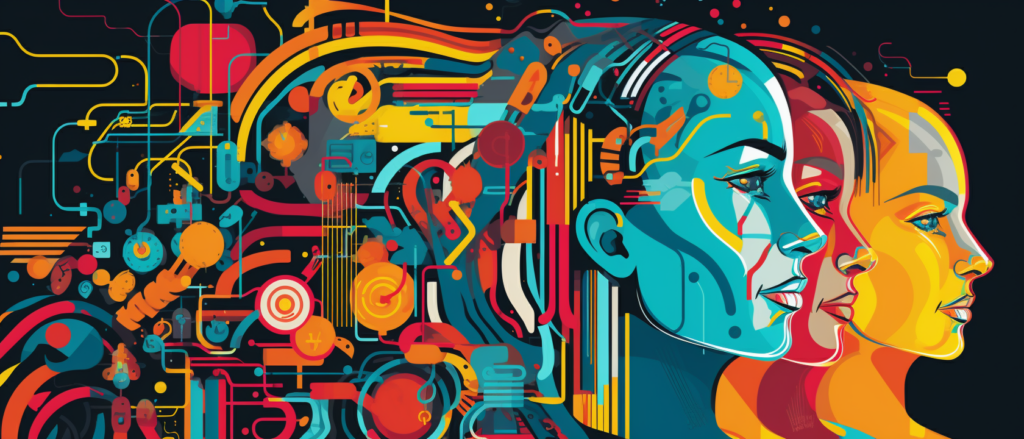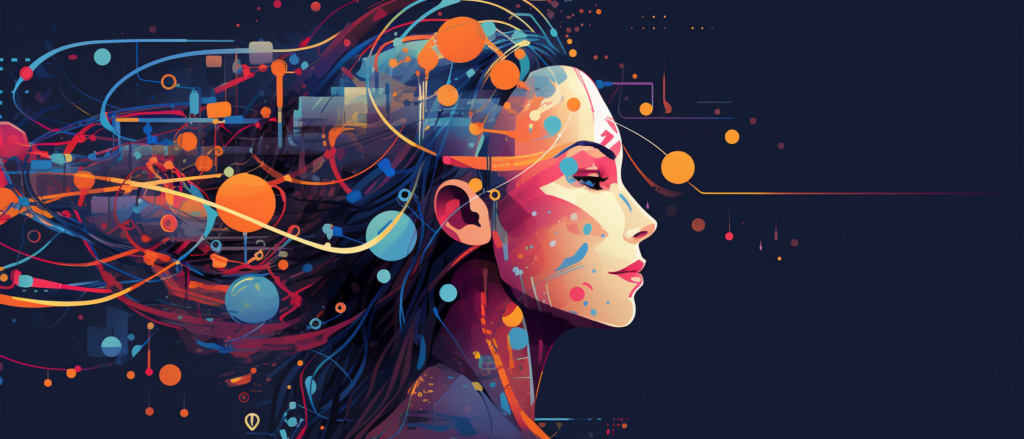Key Takeaways
✅ Definition: Discover how Generative Artificial Intelligence (AI) sets itself apart by creating new content, such as images and text, using intricate patterns understood from extensive data. Grasp its essence and learn how it stands out from other AI subsets.
✅ Applications: Explore the broad scope of Generative AI applications, finding how it transforms industries from healthcare to entertainment. Take a look at how businesses are leveraging it for innovative solutions.
✅ Challenges and Limitations: Tackle the tough questions around the challenges and ethical implications of Generative AI, including biases and the authenticity of its creations. Gain insights into navigating these important issues.

Introduction
Ever stopped to wonder what’s fueling the creativity in machines today? Meet Generative AI: a fascinating branch of technology that’s redefining the boundaries of innovation. Unlike its cousins that predict or classify, this AI magic-maker is all about birthing something new. Think of it as a digital artist, composer, and inventor rolled into one.
Generative models, such as VAEs, GANs, and transformers, are the backbone of this tech. They empower machines to dream up images, sounds, and even words that can sometimes make you question, “Did a human or a machine do this?” The applications? Far-reaching. We’re talking tailored healthcare solutions, blockbuster movie effects, and even personalized shopping experiences.
But it’s not all sunshine and rainbows. With great power comes great- well, challenges. And Generative AI has its fair share, from bias to ethical quandaries over its productions. However, the possibilities – and potential for revenue boosts, improved ROAS and ROI, through the right applications – are too intriguing to ignore.
Top Statistics
| Statistic | Insight |
|---|---|
| Global AI Market Size: Valued at $58.97 billion in 2021 with a CAGR of 36.1% from 2022 to 2030. (Source: Grand View Research) | The rapid growth rate tells us that AI is far from a fleeting trend; it’s shaping up to be the backbone of future innovations. |
| Generative AI Investments: Startups have seen over $1.3 billion in funding between 2015 and 2021. (Source: Crunchbase News) | A sign of confidence from the investor community, highlighting generative AI’s potential to disrupt and create new markets. |
| AI in Healthcare: Predicted to have a CAGR of 41.8% from 2021 to 2028. (Source: Fortune Business Insights) | Healthcare’s high adoption rate shows how crucial AI is in revolutionizing treatments and patient care. |
| Enterprises Using AI: Over half currently, with an expected increase to 75% by 2024. (Source: IDC) | This statistic bolsters the fact that AI is becoming an essential tool across various business sectors, not just tech industries. |
| Generative AI in Cybersecurity: AI security solutions may achieve a market size of $46.3 billion by 2027. (Source: MarketsandMarkets) | With cyber threats on the rise, the integration of generative AI in security underscores its growing role in protecting digital assets and data. |
Understanding Generative AI
Have you ever seen something so amazing and so surprising that you had to ask yourself, “Wait, did a computer really make that?” That’s the reaction many people have to generative artificial intelligence (AI). This isn’t just your regular AI that helps pick what you should watch next on TV; this is AI designed to create new stuff—like a virtual artist or composer. How does it differ from the decision-making AI? Collaborating with human intuition, generative AI gives us not just choices but entirely new creations.
Behind the Scenes of Generative Models
Let’s pull back the curtain on how these things work. You might know deep learning is a big deal in AI, but when it comes to making something out of nothing, we’ve got special tools for that. They sound complex—variational autoencoders and generative adversarial networks—like the kind of thing you’d avoid at a party. But think of them as musicians in a band. Each has a different role but together, they make beautiful music, or in this case, masterpieces of art or medicine or finance.
Advantages Generative AI Brings
What if you could instantly create a stunning picture or write an essay just by describing what you want? That’s the beauty of generative AI. It’s revolutionizing the way we approach creativity, bringing a whole new level of personalization to the table, and making it all seem easy. As we dive deeper into this tech, can you see the kinds of doors it could open for you or your business?
Generative AI Across Industries
This tech isn’t playing around: it’s having a real-world impact, reshaping industries from healthcare to finance. Each sector sees a different revolution where generative AI’s ability to create and innovate shines through. But how exactly are these industries taking advantage of this tech? And more importantly, how is it affecting us, the people behind the scenes and in everyday life?
The Bumps in the Road
Sure, generative AI can be amazing, but what about when it messes up? There’s a bit of a dark side to deal with. Can the AI start mimicking stuff we’d rather it didn’t? What if it starts spitting out things that are, to put it politely, not quite right? And training these systems isn’t a walk in the park either. As we look at these challenges and limitations, let’s think about what it takes to keep these powerful tools in check.
What’s Next for Generative AI?
Imagine what’s around the corner with generative AI. The smart folks behind this technology are dreaming big. What could these future developments look like, and how might they completely turn our world upside down? The possibilities are as vast as they are impressive, stirring the imagination about the directions we’re heading.
Ethics and Playing Fair
When we talk about powerful tech like generative AI, we can’t skip the ethics chat. Keeping our AI creations on the right track means a lot of responsibility. What’s fair game, and how do we keep everyone honest? This is about staying transparent and ensuring that trust is at the core of how this tech evolves. So, let’s keep our eyes open. Generative AI is a fascinating space, full of potential, pitfalls, and the promise of a future that’s ours to shape. Have you started to imagine how you might be part of that future?
AI Marketing Engineers Recommendation
Recommendation 1: Embrace Generative AI for Personalized Content Creation: Let’s face it, everyone’s inbox and social media feeds are overflowing. How do you stand out? Generative AI has become exceptionally good at creating personalized content. It can analyze vast amounts of data to understand what catches your audience’s eye. By tapping into these insights, companies can craft unique messages that resonate on an individual level. Isn’t it cool to know that a machine could potentially help you write the love letter your brand needs to win hearts?
Recommendation 2: Utilize Generative AI for Enhanced Customer Experience: Now, imagine walking into a store where the clerks know your style, your size, and exactly what you came in for – and that’s before they even say hello! That’s kind of what Generative AI can do for your online customer experience. By analyzing behavioral data, AI can generate product recommendations, improve search functionality, and even tailor the user interface to suit personal preferences. Can you see how your customers might like feeling like VIPs every time they click on your site?
Recommendation 3: Adopt Generative AI Tools for Efficient Ad Campaigns: Remember playing darts blindfolded at a funfair? That’s what it’s like to run ad campaigns without target precision. Generative AI tools, using predictive analytics, can optimize ad placements and content, ensuring that your marketing efforts are more like a sharpshooter’s arrow straight to the bullseye. This means less waste on ads that don’t convert, and more bang for your marketing buck. Who wouldn’t want to be the hero who saves the day (and dollars)?
Conclusion
So, what’s the big fuss about Generative AI anyway? After walking through the countless corridors of this technological wonder, it’s hard not to marvel at its transformative power. Generative AI isn’t just another buzzword; it’s a game-changer—a master key unlocking endless doors to the future. Remember those days when we’d chuckle at the idea of machines being ‘creative’? Well, those days are history. Now, they’re crafting art and writing stories; they’re revolutionizing everything from medicine to marketing with tailormade solutions.
But as with all powerful tools, it’s not all roses and sunshine. Generative AI can also stumble, tripping over bias and crashing into privacy concerns. It’s a potent force that we must handle with care, ensuring it works for the benefit of all, without causing harm. Ethics and responsible usage are the guards on this exhilarating ride, making sure it doesn’t go off the rails.
Considering Generative AI is a bit like looking through a telescope; we’re just beginning to glimpse the vast potential out there. Can you imagine what’s on the horizon? Whether it’s curing diseases, personalizing our shopping experiences, or even building unseen worlds in movies and games, Generative AI holds the keys. It’s an invitation to dream bigger, innovate faster, and think deeper. So, are you ready to lean in and shape this courageous new world with responsibility, creativity, and a touch of human ingenuity? Let’s set the gears in motion and watch the magic happen!
FAQs
Question 1: What is generative AI?
Answer: Think of generative AI as a sort of digital chef that whips up brand new dishes by mixing ingredients it’s learned from tons of existing recipes. In technical speak, it’s AI that can produce new content—like text, pictures, tunes, or videos—after studying a whole bunch of existing stuff.
Question 2: How does generative AI work?
Answer: Generative AI is like a sponge—it soaks up patterns from data using complex networks in its artificial brain. Then, it uses this to create fresh material that looks pretty convincing. Picture robots that can dream up their own paintings or write their own songs. That’s the magic of AI models called GANs and VAEs for you!
Question 3: What are some applications of generative AI?
Answer: Oh, it’s all over the place! Creating art, designing products that don’t exist yet, making melodies that’ll get stuck in your head, or even coming up with entirely new data for researchers to study. It’s also making things like understanding what’s in pictures and chatting with bots smoother and more natural.
Question 4: What are the key challenges in generative AI?
Answer: It’s tough work! The AI has to keep things varied and realistic without getting stuck making the same thing over and over. Plus, it’s got to handle all this responsibly, especially when dealing with private or sensitive info. Ethics is a big deal here.
Question 5: How can I get started with generative AI?
Answer: Got a bit of machine learning knowledge tucked under your belt, and know your way around Python and AI toolkits like TensorFlow or PyTorch? Great! There’s a sea of online resources—tutorials, courses, and communities—to dive into. You’ll be creating with AI in no time.
Question 6: Can generative AI replace human creativity?
Answer: Absolutely not. It’s like a supercharged tool that’s here to boost our own creativity. Think of it as a creative sidekick, tossing out a bunch of cool ideas for us to play with.
Question 7: Are there any risks associated with generative AI?
Answer: Sure, as with anything powerful, you gotta handle it with care. There’s the scary stuff like AI fabricating convincing lies or faking identities, plus all the legal mumbo jumbo around who owns what it creates. We’ve got to stay sharp and ensure that generative AI is used for good.
Question 8: What are some advanced topics in generative AI research?
Answer: For you brainy types out there, some hot topics in the AI lab include teaching the AI to create specific images, learning without much guidance, figuring out how to separate and control different features in generated stuff, fusing various types of data, and even trying to make AI decisions easier to understand.
Question 9: Where can I find resources to learn more about generative AI?
Answer: The internet’s brimming with knowledge! Dive into academic papers, online courses, blog posts from AI gurus, and nerdy discussions online. If you’re clear on where to look, there’s no shortage of info out there.
Question 10: Which hashtags should I follow to stay updated on generative AI developments?
Answer: Keep your eyes glued to hashtags like #GenerativeAI, #GANs, #VAEs, #DeepLearning, #MachineLearning, #AIArt, and #SyntheticData on your social media feeds. That’s your ticket to the latest and greatest in AI talk.
Academic References
- Goodfellow, I. J., Pouget-Abadie, J., Mirza, M., Xu, B., Warde-Farley, D., Ozair, S., … & Bengio, Y. (2014). Generative Adversarial Networks. arXiv preprint arXiv:1406.2661. This landmark paper introduces the concept of Generative Adversarial Networks (GANs), which has since revolutionized the way machines create new, often remarkably realistic, images, and it threw open the doors to numerous advancements across various domains.
- Vaswani, A., Shazeer, N., Parmar, N., Uszkoreit, J., Jones, L., Gomez, A. N., … & Polosukhin, I. (2017). Attention Is All You Need. Advances in Neural Information Processing Systems. Introducing the transformative Transformer architecture, this study veers away from traditional recurrent neural networks and molds the future of processing sequence data, fundamentally changing natural language processing as we know it.
- Karras, T., Laine, S., & Aila, T. (2019). A Style-Based Generator Architecture for Generative Adversarial Networks. Proceedings of the IEEE Conference on Computer Vision and Pattern Recognition (CVPR). Here, Karras and colleagues masterfully expand the capabilities of GANs by introducing a style-based approach, allowing not just for finer image generation, but for an unprecedented control over the styling elements within the images.
- Raffel, C., Shazeer, N., Roberts, A., Lee, K., Narang, S., Matena, M., … & Liu, Y. (2020). Exploring the Limits of Transfer Learning with a Unified Text-to-Text Transformer. Transactions of the Association for Computational Linguistics. This insightful study dives deep into the powerhouse capabilities of pretrained language models, demonstrating their sheer efficiency and adaptability across a vast array of natural language processing tasks, which has quickly made them a standard in the field.











